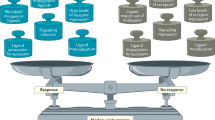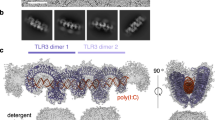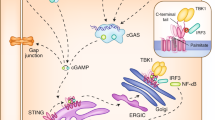Abstract
Toll-like receptor 8 (TLR8) recognizes viral or bacterial single-stranded RNA (ssRNA) and activates innate immune systems. TLR8 is activated by uridine- and guanosine-rich ssRNA as well as by certain synthetic chemicals; however, the molecular basis for ssRNA recognition has remained unknown. In this study, to elucidate the recognition mechanism of ssRNA, we determined the crystal structures of human TLR8 in complex with ssRNA. TLR8 recognized two degradation products of ssRNA—uridine and a short oligonucleotide—at two distinct sites: uridine bound the site on the dimerization interface where small chemical ligands are recognized, whereas short oligonucleotides bound a newly identified site on the concave surface of the TLR8 horseshoe structure. Site-directed mutagenesis revealed that both binding sites were essential for activation of TLR8 by ssRNA. These results demonstrate that TLR8 is a sensor for both uridine and a short oligonucleotide derived from RNA.
This is a preview of subscription content, access via your institution
Access options
Subscribe to this journal
Receive 12 print issues and online access
$189.00 per year
only $15.75 per issue
Buy this article
- Purchase on Springer Link
- Instant access to full article PDF
Prices may be subject to local taxes which are calculated during checkout






Similar content being viewed by others
References
Song, D.H. & Lee, J.O. Sensing of microbial molecular patterns by Toll-like receptors. Immunol. Rev. 250, 216–229 (2012).
Akira, S. & Takeda, K. Toll-like receptor signalling. Nat. Rev. Immunol. 4, 499–511 (2004).
Poltorak, A. et al. Defective LPS signaling in C3H/HeJ and C57BL/10ScCr mice: mutations in Tlr4 gene. Science 282, 2085–2088 (1998).
Shimazu, R. et al. MD-2, a molecule that confers lipopolysaccharide responsiveness on Toll-like receptor 4. J. Exp. Med. 189, 1777–1782 (1999).
Alexopoulou, L., Holt, A.C., Medzhitov, R. & Flavell, R.A. Recognition of double-stranded RNA and activation of NF-κB by Toll-like receptor 3. Nature 413, 732–738 (2001).
Alexopoulou, L. et al. Hyporesponsiveness to vaccination with Borrelia burgdorferi OspA in humans and in TLR1- and TLR2-deficient mice. Nat. Med. 8, 878–884 (2002).
Takeuchi, O. et al. Cutting edge: role of Toll-like receptor 1 in mediating immune response to microbial lipoproteins. J. Immunol. 169, 10–14 (2002).
Akira, S. TLR signaling. Curr. Top. Microbiol. Immunol. 311, 1–16 (2006).
Kawai, T. & Akira, S. The role of pattern-recognition receptors in innate immunity: update on Toll-like receptors. Nat. Immunol. 11, 373–384 (2010).
Roach, J.C. et al. The evolution of vertebrate Toll-like receptors. Proc. Natl. Acad. Sci. USA 102, 9577–9582 (2005).
Diebold, S.S., Kaisho, T., Hemmi, H., Akira, S. & Sousa, C.R.E. Innate antiviral responses by means of TLR7-mediated recognition of single-stranded RNA. Science 303, 1529–1531 (2004).
Heil, F. et al. Species-specific recognition of single-stranded RNA via toll-like receptor 7 and 8. Science 303, 1526–1529 (2004).
Wang, J.P. et al. Toll-like receptor-mediated activation of neutrophils by influenza A virus. Blood 112, 2028–2034 (2008).
Lund, J.M. et al. Recognition of single-stranded RNA viruses by Toll-like receptor 7. Proc. Natl. Acad. Sci. USA 101, 5598–5603 (2004).
Triantafilou, K. et al. Human cardiac inflammatory responses triggered by Coxsackie B viruses are mainly Toll-like receptor (TLR) 8-dependent. Cell. Microbiol. 7, 1117–1126 (2005).
Cervantes, J.L. et al. Human TLR8 is activated upon recognition of Borrelia burgdorferi RNA in the phagosome of human monocytes. J. Leukoc. Biol. 94, 1231–1241 (2013).
Gantier, M.P. et al. Genetic modulation of TLR8 response following bacterial phagocytosis. Hum. Mutat. 31, 1069–1079 (2010).
Hornung, V. et al. Sequence-specific potent induction of IFN-α by short interfering RNA in plasmacytoid dendritic cells through TLR7. Nat. Med. 11, 263–270 (2005).
Sioud, M. Induction of inflammatory cytokines and interferon responses by double-stranded and single-stranded siRNAs is sequence-dependent and requires endosomal localization. J. Mol. Biol. 348, 1079–1090 (2005).
Sioud, M. Single-stranded small interfering RNA are more immunostimulatory than their double-stranded counterparts: a central role for 2′-hydroxyl uridines in immune responses. Eur. J. Immunol. 36, 1222–1230 (2006).
Barrat, F.J. et al. Nucleic acids of mammalian origin can act as endogenous ligands for Toll-like receptors and may promote systemic lupus erythematosus. J. Exp. Med. 202, 1131–1139 (2005).
Diebold, S.S. et al. Nucleic acid agonists for Toll-like receptor 7 are defined by the presence of uridine ribonucleotides. Eur. J. Immunol. 36, 3256–3267 (2006).
Forsbach, A. et al. Identification of RNA sequence motifs stimulating sequence-specific TLR8-dependent immune responses. J. Immunol. 180, 3729–3738 (2008).
Hemmi, H. et al. Small anti-viral compounds activate immune cells via the TLR7 MyD88-dependent signaling pathway. Nat. Immunol. 3, 196–200 (2002).
Jurk, M. et al. Human TLR7 or TLR8 independently confer responsiveness to the antiviral compound R-848. Nat. Immunol. 3, 499 (2002).
Kokatla, H.P. et al. Structure-based design of novel human Toll-like receptor 8 agonists. ChemMedChem 9, 719–723 (2014).
Honda, K. et al. IRF-7 is the master regulator of type-I interferon-dependent immune responses. Nature 434, 772–777 (2005).
Kawai, T. et al. Interferon-α induction through Toll-like receptors involves a direct interaction of IRF7 with MyD88 and TRAF6. Nat. Immunol. 5, 1061–1068 (2004).
Tanji, H., Ohto, U., Shibata, T., Miyake, K. & Shimizu, T. Structural reorganization of the Toll-like receptor 8 dimer induced by agonistic ligands. Science 339, 1426–1429 (2013).
Li, Y. et al. Extraordinary GU-rich single-strand RNA identified from SARS coronavirus contributes an excessive innate immune response. Microbes Infect. 15, 88–95 (2013).
Vollmer, J. et al. Immune stimulation mediated by autoantigen binding sites within small nuclear RNAs involves Toll-like receptors 7 and 8. J. Exp. Med. 202, 1575–1585 (2005).
Fabbri, M. et al. MicroRNAs bind to Toll-like receptors to induce prometastatic inflammatory response. Proc. Natl. Acad. Sci. USA 109, E2110–E2116 (2012).
Karikó, K., Buckstein, M., Ni, H. & Weissman, D. Suppression of RNA recognition by Toll-like receptors: the impact of nucleoside modification and the evolutionary origin of RNA. Immunity 23, 165–175 (2005).
Otwinowski, Z. & Minor, W. Processing of X-ray diffraction data collected in oscillation mode. Methods Enzymol. 276, 307–326 (1997).
Battye, T.G., Kontogiannis, L., Johnson, O., Powell, H.R. & Leslie, A.G. iMOSFLM: a new graphical interface for diffraction-image processing with MOSFLM. Acta Crystallogr. D Biol. Crystallogr. 67, 271–281 (2011).
Vagin, A. & Teplyakov, A. Molecular replacement with MOLREP. Acta Crystallogr. D Biol. Crystallogr. 66, 22–25 (2010).
Emsley, P. & Cowtan, K. Coot: model-building tools for molecular graphics. Acta Crystallogr. D Biol. Crystallogr. 60, 2126–2132 (2004).
Murshudov, G.N., Vagin, A.A. & Dodson, E.J. Refinement of macromolecular structures by the maximum-likelihood method. Acta Crystallogr. D Biol. Crystallogr. 53, 240–255 (1997).
Adams, P.D. et al. PHENIX: building new software for automated crystallographic structure determination. Acta Crystallogr. D Biol. Crystallogr. 58, 1948–1954 (2002).
Laskowski, R.A., MacArthur, M.W., Moss, D.S. & Thornton, J.M. PROCHECK: a program to check the stereochemical quality of protein structures. J. Appl. Crystallogr. 26, 283–291 (1993).
Taoka, M. et al. An analytical platform for mass spectrometry-based identification and chemical analysis of RNA in ribonucleoprotein complexes. Nucleic Acids Res. 37, e140 (2009).
Acknowledgements
We thank the beamline staff members at Photon Factory and SPring-8 for their assistance with data collection. We also thank M. Osawa and I. Shimada for their help with the ITC data acquisition. This work was supported by Grants-in-Aid from the Japan Society for the Promotion of Science KAKENHI, grant nos. 25121709, 25115504, 26711002 (U.O.), 25860354 (T. Shibata), 25253032 (K.M.), 23116007 and 25291010 (T. Shimizu); by the Takeda Science Foundation (U.O. and T. Shimizu); and by the Mochida Memorial Foundation for Medical and Pharmaceutical Research (U.O.).
Author information
Authors and Affiliations
Contributions
H.T. and U.O. performed the crystallization and structure determination. T. Shibata and K.M. performed the functional analyses. M.T., Y.Y. and T.I. performed LC-MS. H.T., U.O., T. Shibata, K.M. and T. Shimizu analyzed the results. All authors contributed to writing the manuscript.
Corresponding author
Ethics declarations
Competing interests
The authors declare no competing financial interests.
Integrated supplementary information
Supplementary Figure 1 Structures of TLR8 in complex with ssRNA.
(a, b) Structures of TLR8–ssRNA40 (a) and TLR8–ORN06S (b). Front (left) and side (right) views of the structures. Uridine is recognized at the 1st site, and UG is recognized at the 2nd site.
(c) Surface representations of a protomer of TLR8–ORN06 dimer. The protein-protein interface is shown in orange, the 1st site is shown in red, and the 2nd site is shown in purple.
(d) Superposition of oligonucleotides bound at the 2nd sites of TLR8–ORN06, TLR8–ssRNA40 and TLR8–ORN06S. UG in TLR8–ORN06, TLR8–ssRNA40 and TLR8–ORN06S are shown in purple, cyan and orange, respectively.
Supplementary Figure 2 Electron density maps for the bound ligand.
(a-d) Electron density (shown in gray) contoured around the ligand at the 3.0σ level in the Fo-Fc map; uridine and UG in TLR8– ORN06 (a), TLR8–ssRNA40 (b), TLR8– ORN06S (c) and uridine in TLR8–uridine (d).
Supplementary Figure 3 Close-up views of the first and second sites of TLR8–ssRNA40 and TLR8–ORN06S.
(a) The 1st site of TLR8–ssRNA40. Uridine (shown in yellow) was modeled into the structure.
(b) The 2nd site of TLR8–ssRNA40. Electron density corresponding to a pyrimidine-purine dinucleotide was observed at the 2nd site and assigned tentatively as UG (shown in purple).
(c) The 1st site of TLR8–ORN06S. Uridine was modeled into the structure, and is shown in yellow.
(d) The 2nd site of TLR8–ORN06S. UG was modeled into the structure, and is shown in purple.
Supplementary Figure 4 Sequence alignment of human, bovine and mouse TLR7 and TLR8.
Sequence alignments are displayed for each LRR module. The 1st and 2nd sites deduced from chain A of the TLR8–ORN06 complex are indicated by yellow and blue highlightings, respectively. The residues missing in the structure are highlighted in grey. Alignments were performed using CLUSTALW software (EMBL-European Bioinformatics Institute). Residues are colored to indicate the degree of similarity; red residues display the highest similarity, followed by green, blue, and then black (lowest similarity).
Supplementary Figure 5 Structures of TLR8 in complex with uridine.
(a) Front (left) and side (right) views of the structure. Uridine is recognized at the 1st site.
(b) Residues involved the interaction of TLR8 with uridine. The C atoms of the ligand molecules are shown in yellow. Water molecules mediating ligand recognition are indicated by red spheres, and hydrogen bonds are indicated by dashed lines.
Supplementary Figure 6 Small-angle X-ray scattering analysis of TLR8 in complex with ssRNA.
Scattering curves of hTLR8 by SAXS experiments are shown. The proteins used for SAXS were unliganded hTLR8 (red), hTLR8 in the presence of ORN06 (blue), and hTLR8 in the presence of R848 (black).
Supplementary information
Supplementary Text and Figures
Supplementary Figures 1–6 (PDF 1837 kb)
Rights and permissions
About this article
Cite this article
Tanji, H., Ohto, U., Shibata, T. et al. Toll-like receptor 8 senses degradation products of single-stranded RNA. Nat Struct Mol Biol 22, 109–115 (2015). https://doi.org/10.1038/nsmb.2943
Received:
Accepted:
Published:
Issue Date:
DOI: https://doi.org/10.1038/nsmb.2943
This article is cited by
-
Strategies to reduce the risks of mRNA drug and vaccine toxicity
Nature Reviews Drug Discovery (2024)
-
TLR8 escapes X chromosome inactivation in human monocytes and CD4+ T cells
Biology of Sex Differences (2023)
-
LDL delivery of microbial small RNAs drives atherosclerosis through macrophage TLR8
Nature Cell Biology (2022)
-
Regulation of the nucleic acid-sensing Toll-like receptors
Nature Reviews Immunology (2022)
-
Structural and functional implications of leucine-rich repeats in toll-like receptor1 subfamily
Journal of Biosciences (2022)



